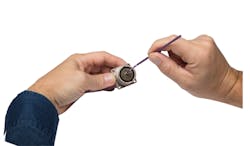Successfully cleaning different fiber-connector types
Tools and practices will differ depending on the type of fiber connector you’re cleaning.
By Brian Teague, Sticklers and Tyler Vander Ploeg, VIAVI Solutions
In previous columns, we discussed the importance of the Inspect Before You Connect (IBYC) process, and how the process is vital to the successful performance of a network. In this issue, we focus on cleaning and how to do itsuccessfully.
Cleaning is not merely important. It is critical to the long-term reliability of any network. But what are the best tools for the job? It all depends on the contamination you are dealing with. The stick and the “clicker”-style cleaning tools work well in different situations, so it is important to assess what you are cleaning first with the IBYC process.
IBYC is a procedure that will ensure perfectly clean fiber every time and includes the simple steps of: inspect, clean (if required), re-inspect, and finally connect. Undertaking the IBYC process on both sides of a fiber connection will guarantee fiber connectors are free ofcontamination.
Cleaning sticks, like this one, and wipes work well on low fiber counts. They deal well with high contamination, and are often used in the field where a high level of contamination is more likely.
Stick or clicker?
If it is found following the inspection that cleaning is required, there is a choice of cleaning tools. The more “traditional” method of sticks and wipes are great on low fiber counts. They are more thorough to easily deal with high contamination, working well out in the field where this is more likely. When using stick cleaners, only rotate in the one direction; usually 4 to 8 rotations is sufficient. And importantly, remember to use only one stick per endface to avoid cross-contamination.
The “modern” clicker-type cleaners and cassette tools are popular within the industry as they are extremely convenient and quick. They are built for high-fiber-count applications and are a good option for mediumcontamination.
It is important to know how to use all of these fiber cleaning tools correctly, because if used improperly, they can cause more damage than good. One example is the buildup of electrostatic charge. Because contamination such as dust particles are so small, they can be locked into place on an endface by a static charge generated when using improper cleaning methods.
Static charge can come from using a mechanical cleaning tool multiple times in quick succession, or wiping an endface with a dry wipe. Because fiber connectors are made with dielectric materials, they are effectively an electrical insulator, so the static charge has no place to go and can stick to the endface indefinitely if not cleaned correctly.
Clicker-style cassette tools like this one are convenient, quick and popular. Clicker-type tools are built for high-fiber-count applications and are a good option for medium levels of contamination.
Cleaning fluid: Choose wisely
The easiest way to eliminate contamination caused by an electrostatic charge is through a wet-dry cleaning process using an appropriate, optical-grade cleaning fluid. This becomes the conductive medium that dissipates the electrostatic charge.
To achieve the best results, select a cleaning fluid that will not leave any residues and comes in hermetically sealed containers to prevent cross-contamination and spills.
Also ensure they are fast-drying, non-flammable, and have a low surface tension. The fast-drying feature is especially important when cleaning fiber, as there is not enough time for moisture to attract to the fluid, therefore stoppingcontamination.
Look at the fluid’s material compatibility. A well-engineered cleaning fluid will be compatible and safe to use on a wide range of materials including optics, plastics, metals, elastomers, electronic assemblies and adhesives.
Finally, think about where the cleaning fluid is being stored. If it is kept on a truck in cold temperatures, don’t choose a water-based cleaning fluid as it will freeze.
Using a wet-dry cleaning process with appropriate optical-grade cleaning fluid is the easiest way to eliminate contamination caused by an electrostatic charge.
Finally, and importantly, always remember to be proactive and use the IBYC process to ensure fiber connectors are free of contamination. A common mistake is cleaning without first inspecting the fiber. Cleaning is only necessary if the connector is contaminated; there is no need to use a cleaning tool if the fiber is already clean. As a reminder, be sure to inspect both ends of the connector pair just before mating, and don’t forget to inspect new jumpers and patch cords even if they have protective endcaps on them—as this does not guarantee cleanliness.
Editor’s note: During awebcast seminar we hosted on September 6, 2018, this article’s co-author Brian Teague delivered a presentation focused on fiber cleaning. During the seminar, an attendee asked Teague the following question: Can we use a toothpick and cotton ball to clean the inside of an adapter? Teague answered the question clearly and politely. Nonetheless, the fact that question was asked is testimony to the need for continuing education about fiber-cleaning best practices.u
Brian Teague is product manager for Sticklers Fiber Optic Cleaners by MicroCare Corp., a manufacturer of products for precision cleaning, coating and lubrication.
Tyler Vander Ploeg, RCDD is the fiber solutions market manager for VIAVI Solutions, a provider of network test, monitoring and assurance solutions to communications service providers, enterprises and their ecosystems.



